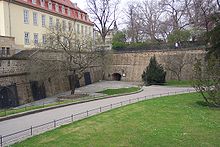Bear kennel (Dresden)
The Bärenzwinger is a student club in the center of Dresden . It is located near the Albertinum and is part of the historic Dresden fortifications .
history
The buildings, now known as the Bärenzwinger , were built by Caspar Voigt von Wierandt between 1519 and 1521 and in the course of the north-east expansion of the Dresden city fortifications ( Bastion Venus / Jungfernbastei ) by the carpenter and screw maker Paul Buchner (1531–1607), who was born in Nuremberg , from 1590 to 1592 expanded. From 1567 onwards, Buchner was in charge of the expansion of the city fortifications and in 1576 was appointed Oberzeugmeister of the city of Dresden. Other formative buildings in Dresden come from him, such as the Dresden armory (today Albertinum), horse stable and stable courtyard of the Dresden Residenzschloss ( Johanneum , today Transport Museum), the old Gewandhaus u. a. m.
The designation bear kennel has nothing to do with the predator bear , but goes back to terms of the fortress construction: Batardeau (damming / Schleusendamm) became bear and kennel refers to the passage between the inner and outer moat wall - i.e. kennel at the bear . While the inner city wall is well preserved, only rudiments of the outer moat wall are visible.
The construction of the Bärenzwinger served to protect the Schleusendamm, which separated the city moat from the Elbe river . The cannon openings, through one of which you enter the student club today, as well as the partially preserved forging facilities, bear witness to this. The area between the Bärenzwinger and the Terrassenufer was later used as a gondola harbor , filled in in 1856 and designed as a park.
As a result of the progress in weapon technology, the fortress lost its military importance and so the part of the grounds facing the Elbe came into the possession of the Saxon Prime Minister Heinrich von Brühl (1700–1763), who had it redesigned into a garden in 1748/49.
By order of Napoleon , the fortress was razed in 1809 and the aboveground buildings were demolished in 1830, and the underground casemates were filled with the rubble , so that the former cannon yard behind the big barrel filled with this rubble to the ceiling when it left the city has been. Later finds of ointment pots and other containers as well as recesses in the walls of the unfilled barrel vaults indicate a temporary use as storage rooms for the court pharmacy of the Dresden Surgical and Medicinal Academy founded in 1815 under Carl Gustav Carus .
During the Second World War , the vaults were used as air raid shelters.
History of the student club

The Bärenzwinger student club , located in the historic vaults, connects the student bar with the cultural scene .
In the mid-1960s, architecture students from the Technical University of Dresden looked for rooms for a meeting place and they found what they were looking for in the area of the old fortress. With the support of the student body, the vaults were freed from rubble and expanded in thousands of voluntary unpaid hours as part of the National Reconstruction Works (NAW) . On June 15, 1968, the club began operating under the name Bärenzwinger student club in the small tons and the inner courtyard.
The talk show "Treff mit OF" was recorded for GDR television with the entertainer OF Weidling.
In 1986 the large bin was inaugurated as an event hall and the architects' club became a “Central FDJ student club of the TU Dresden”. The Tonne jazz club was just 100 meters away .
Since 1990 the club has been sponsored by a non-profit association (Studentenclub Bärenzwinger eV). The cultural center, which is now not only open to students, is visited by around 150,000 young people every year. The highlights of the annual program are the May morning pint on May 1st, events for the Dresden Dixieland Festival and the Dresden Santa Claus sacking relay marathon , a relay race in which students dressed as Santa Claus jump around in sacks.
On June 1, 2000, the student club had to hand over its large bin - like the Kanonenhof before it - to the Evangelical Reformed Congregation, which operates an old people's home, after losing a legal dispute. This reduced the capacity from 500 to 150 guests.
The Elbe flood in 2002 also hit the bear pen. Thanks to the initiative of the members and friends of the club and with the support of numerous donors and the state of Saxony , operations in the completely renovated student club were resumed in April 2003.
Since April 2006, the inner courtyard of the Bärenzwinger has been covered with glass soundproofing. This means that the courtyard, which was previously not usable, can be used for events without being influenced by the weather. The capacity rose again to 250 guests.
The program includes concerts, mostly by local bands, movies, readings, lectures, cultural forums and discos.
Since 2004, the Dresden Summer Theater has been held annually from mid-July to early September in the Kanonenhof with around 40 performances directed by Peter Förster.
When the Elbe floods in 2013 , water levels of almost 9 meters threatened the bear pen again. By building a dam that took days, the student club, supported by members of other Dresden student clubs and other volunteers, was able to prevent the Bärenzwinger and the neighboring catering and parish rooms from being flooded.
Web links
literature
- 30 years of the Bärenzwinger student club. The encyclopedia. ed. from the Bärenzwinger student club, Müllrose 1998.
- Eva Papke: Dresden Fortress . Michel Sandstein Verlagsgesellschaft, Dresden 1999, ISBN 3-930382-12-1 .
Individual evidence
Coordinates: 51 ° 3 ′ 9 ″ N , 13 ° 44 ′ 43 ″ E
